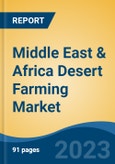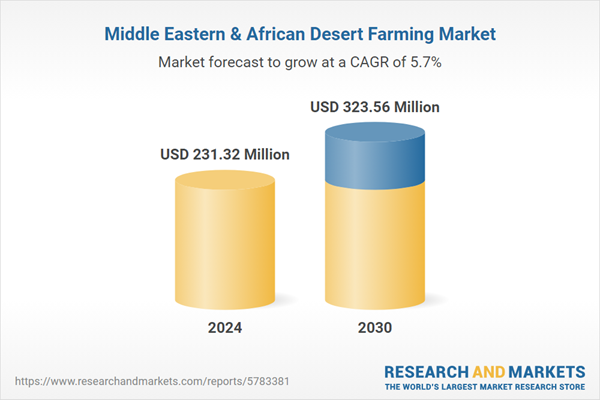Speak directly to the analyst to clarify any post sales queries you may have.
10% Free customizationThis report comes with 10% free customization, enabling you to add data that meets your specific business needs.
Key Market Drivers
Water Scarcity and the Need for Efficient Water Management
Water scarcity is one of the most pressing challenges in the Middle East & Africa (MEA) region, where vast desert landscapes and arid climates limit access to natural freshwater resources. With rising population growth and increasing demand for food production, governments and private investors are heavily focused on sustainable water management technologies to support desert farming.Drip irrigation, hydroponics, aeroponics, and desalination have emerged as vital solutions, significantly reducing water wastage and enabling agriculture in extreme environments. Countries like Saudi Arabia, UAE, and Egypt are investing in large-scale desalination plants to convert seawater into irrigation water, ensuring a sustainable water supply for farming. Innovations such as solar-powered irrigation systems and smart water sensors that monitor moisture levels in real-time are also helping farmers optimize water usage, making desert farming more viable.
Key Market Challenges
High Initial Investment and Operational Costs
One of the biggest challenges in desert farming is the high initial capital investment required for setting up advanced farming systems. Technologies such as hydroponics, aeroponics, vertical farming, and controlled-environment agriculture (CEA) require specialized infrastructure, climate control systems, and automated irrigation technologies, all of which demand significant financial resources.Setting up a hydroponic or aeroponic farm in the desert involves costs associated with greenhouses, LED lighting systems, water filtration units, and nutrient delivery mechanisms, making it an expensive venture compared to traditional soil-based farming. Even though governments and private investors are promoting desert farming through funding and subsidies, small-scale farmers struggle to access capital due to high interest rates and limited financial support.
In addition to setup costs, operational expenses remain high due to the energy-intensive nature of controlled farming systems. Greenhouses and vertical farms require constant electricity supply for cooling, heating, and lighting, which is a challenge in regions where energy infrastructure is underdeveloped or unreliable. Solar-powered farming systems offer a potential solution, but they too require substantial upfront investment.
Moreover, the cost of importing high-quality seeds, specialized nutrients, and advanced farming equipment adds to the financial burden. Countries in North America, Europe, and Asia manufacture most of the desert farming technologies, making importation costly due to tariffs, taxes, and logistical expenses. Until local production of desert farming equipment becomes widespread, cost-related barriers will continue to hinder the expansion of desert agriculture in the MEA region.
Key Market Trends
Foreign Direct Investments (FDI) and Agribusiness Expansion in the Region
The market is attracting significant Foreign Direct Investment (FDI) from international agritech companies and venture capital firms. With global interest in sustainable food production and climate-adaptive agriculture, major investors are pouring funds into desert farming startups, hydroponic projects, and vertical farming companies in the region. In March 2022, Under the patronage of His Highness Sheikh Khalifa bin Zayed Al Nahyan, President of the United Arab Emirates, regional ministers of agriculture, NARS representatives, and key stakeholders endorsed the Integrated Desert Farming Innovation Platform presented by Mr. Aly Abousabaa, CGIAR Regional Director of CWANA and Director General of ICARDA. The platform was introduced during a KIADPAI / CGIAR side-event held on March 14-15 as part of the 7th International Date Palm Conference in Abu Dhabi, highlighting innovative solutions for sustainable desert agriculture.Leading agribusiness corporations from Europe, North America, and Asia are forming joint ventures with MEA-based firms, bringing advanced farming techniques, AI-driven automation, and data analytics into the sector. Countries like Saudi Arabia, the UAE, and Egypt are also leasing agricultural land abroad while simultaneously developing desert farming solutions to strengthen domestic food security.
Key Market Players
- Red Sea Farm Cooperative
- Desert Hydroponics (Aljoaib Holdings)
- Vertical Farms Company
- Desert Growing
- Elite Agro LLC
- Emirates Hydroponics Farms
- Farminova Plant Factory
- Future Farms South Africa
- FlowGrow Hydroponics
- Hydroponics Africa Limited
Report Scope:
In this report, the Middle East & Africa Desert Farming Market has been segmented into the following categories, in addition to the industry trends which have also been detailed below:Middle East & Africa Desert Farming Market, By Technique:
- Greenhouse
- Hydroponics
- Nano clay
- Hydrogels
- Others
Middle East & Africa Desert Farming Market, By Crop Type:
- Dates
- Alfalfa
- Eggplant
- Peppers
- Tomatoes
- Melon
- Others
Middle East & Africa Desert Farming Market, By Country:
- Israel
- UAE
- Saudi Arabia
- Algeria
- Egypt
- Oman
- Turkey
- South Africa
- Kuwait
- Qatar
Competitive Landscape
Company Profiles: Detailed analysis of the major companies present in the Middle East & Africa Desert Farming Market.Available Customizations:
With the given market data, the publisher offers customizations according to a company's specific needs. The following customization options are available for the report.Company Information
- Detailed analysis and profiling of additional market players (up to five).
This product will be delivered within 1-3 business days.
Table of Contents
Companies Mentioned
- Red Sea Farm Cooperative
- Desert Hydroponics (Aljoaib Holdings)
- Vertical Farms Company
- Desert Growing
- Elite Agro LLC
- Emirates Hydroponics Farms
- Farminova Plant Factory
- Future Farms South Africa
- FlowGrow Hydroponics
- Hydroponics Africa Limited
Table Information
| Report Attribute | Details |
|---|---|
| No. of Pages | 120 |
| Published | March 2025 |
| Forecast Period | 2024 - 2030 |
| Estimated Market Value ( USD | $ 231.32 Million |
| Forecasted Market Value ( USD | $ 323.56 Million |
| Compound Annual Growth Rate | 5.7% |
| Regions Covered | Africa, Middle East |
| No. of Companies Mentioned | 10 |









